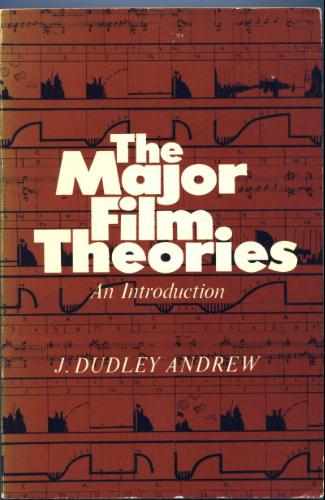From Sight and Sound (Summer 1977). -– J.R.

THE MAJOR FILM THEORIES: AN INTRODUCTION
By J. Dudley Andrew
OXFORD UNIVERSITY PRESS, £2.50(paperback)
The widespread distrust of film theory still persisting in mainstream criticism is scarcely confined to Anglo-American film culture. Less than a decade back, when Noël Burch’s Praxis du cinéma -– later translated as Theory of Film Practice –- first appeared in France, someone at Gallimard hit on a rather demented sales pitch, and the book was marketed with a wraparound banner boldly proclaiming, ‘Contre toute théorie.’ The curious science fiction tone of this declaration highlights a subterranean bias which informs most film reviewing on and off the continent: the idea that theory is an option best left to dusty academicians, while everyone else is better off operating on free-floating intelligence and intuition. Ironically, this is an assumption which expresses a theory of its own: that knowledge is essentially empirical. And the definition accorded to ’empiricist’ by the Concise Oxford may be worth at least considering:'(person) relying solely on experiment; quack.’
In all fairness to ‘anti-theorists’, it should be conceded that science and art are hardly the same thing. If a sizeable part of our knowledge of the former is grounded in theory, the parti pris underlying our knowledge of cinema tends to be a much more random affair, a generally murky blend of half-examined predilections and working hypotheses. Yet it is precisely here that theory becomes a useful tool even to the non-specialist: a working model that can serve as a test to one’s own assumptions. And the bracing value of J. Dudley Andrew’s guidebook — subtitled ‘An Introduction’, and clearly designed to indicate some of the more accessible routes into diverse kinds of material — is that it is virtually the first in English to cover a relatively broad range of figures.
Andrew establishes his modus operandi in a succinct introduction, which promises to compare theorists on questions about ‘raw material’, ‘methods and techniques’, ‘forms and shapes’ and ‘purpose and value’. He then proceeds to explore theorists in three successive categories: ‘The Formative Tradition’, ‘Realist Film Theory’ and ‘Contemporary French Film Theory’. The first of these includes not only Arnheim, Eisenstein and Balazs, but also Hugo Munsterberg, a fascinating pioneer whose seminal work in 1916, The Photoplay: A Psychological Study (republished in America in 1970), has so far received scant attention in England. Bazin and Kracauer claim the section on realist theory, while Mitry, Metz and -– rather more unexpectedly –- Amédée Ayfre and Henri Agel(along with brief acknowledgments of Burch and the ‘militant critics at Cahiers du Cinéma and Cinétique‘) comprise
the survey of contemporary French theory. Overall, a somewhat conservative list, but one that is useful enough for Andrew’s purposes. If some of his treatments skirt areas that more specialized studies have examined in depth (cf., in particular, Martin Jay’s revealing essay on the career of Siegfried Kracauer in Salmagundi Nos. 31-32, which appeared at roughly the same time as Andrew’s book), and one regrets in particular the avoidance of any detailed discussion of Vertov, he generally remains lucid and convincing on his chosen figures.
There are no ‘objective’ accounts of theory any more than there are‘objective’ theories, and it seems worth indicating something of the nature of Andrew’s own bents. For the most part, his expositions of Munsterberg, Arnheim, Eisenstein, Belazs and Kracauer seem unusually detached and judicious, pointing up the peculiar strengths and weaknesses of each without suggesting that he has any particular axe to grind. His less questioning admiration for Bazin diverts this tendency somewhat; and the subsequent chapters on Mitry and Metz, however respectful, hint at a certain dissatisfaction with much contemporary theory which helps to explain the decision to end the survey with Ayfre and Agel. Arguing that the materialism of the semioticians and the determinism of writers like Michel Foucault closes off too many possibilities of exploration within the notion of ‘art as freedom’, he cites the phenomenology of Ayfre, Agel and Roger Munier as a viable route leading back to some of the avenues opened up by Bazin.
A debatable conclusion, but Andrew takes great pains not to overstate his case: semiotics ‘may someday teach us how cinema is possible and why it generally looks the way it does. Phenomenology will continue the more uncertain venture of trying to describe for us the value and importance which all of us have sensed within certain moments of cinema.’ And the likeable thing about this conscientious study is that, far from seeking to cancel out the potential benefits of any theoretical approach, it endeavors to establish terms for a disciplined but supple discussion where agreements and disagreements alike can be rationally formulated.
JONATHAN ROSENBAUM
